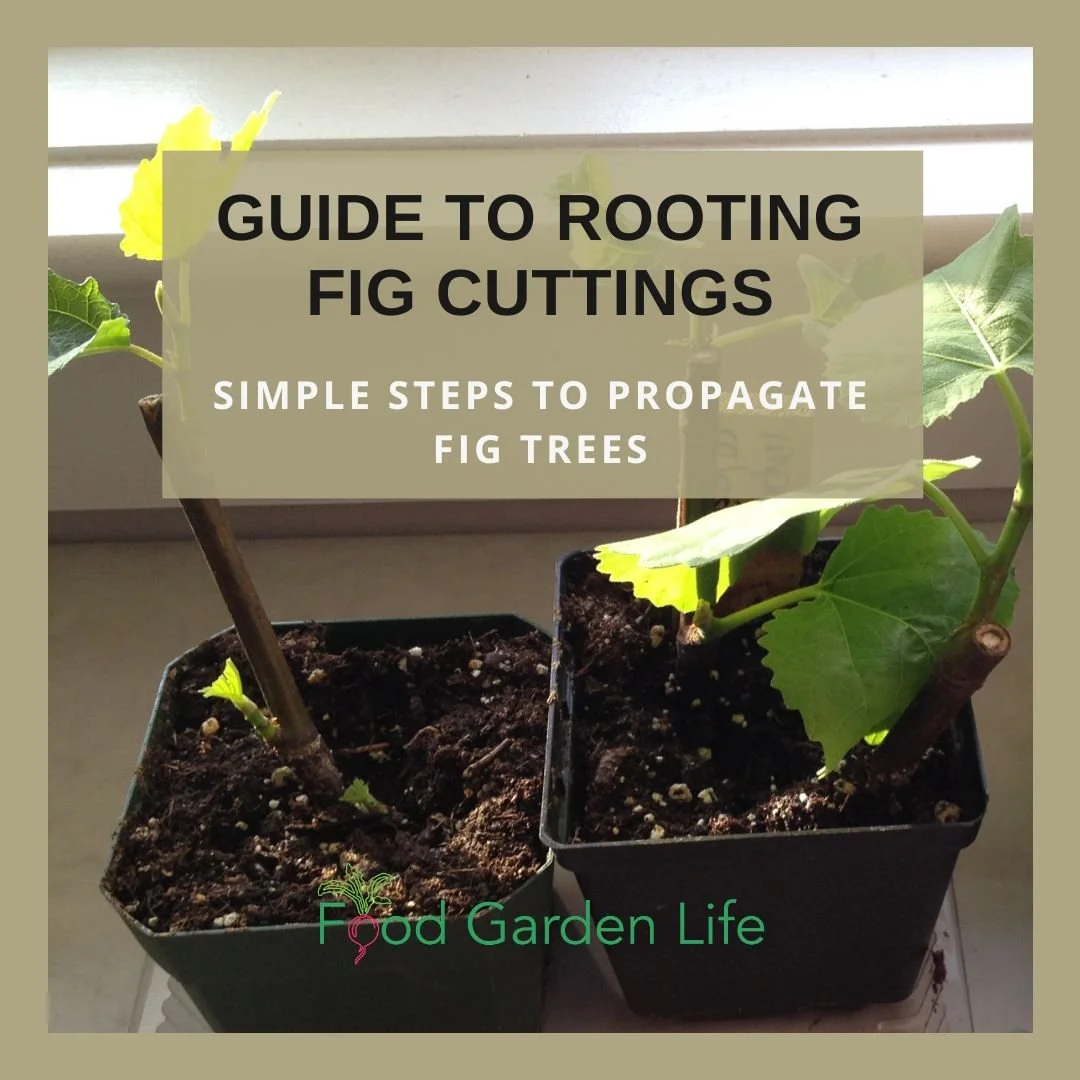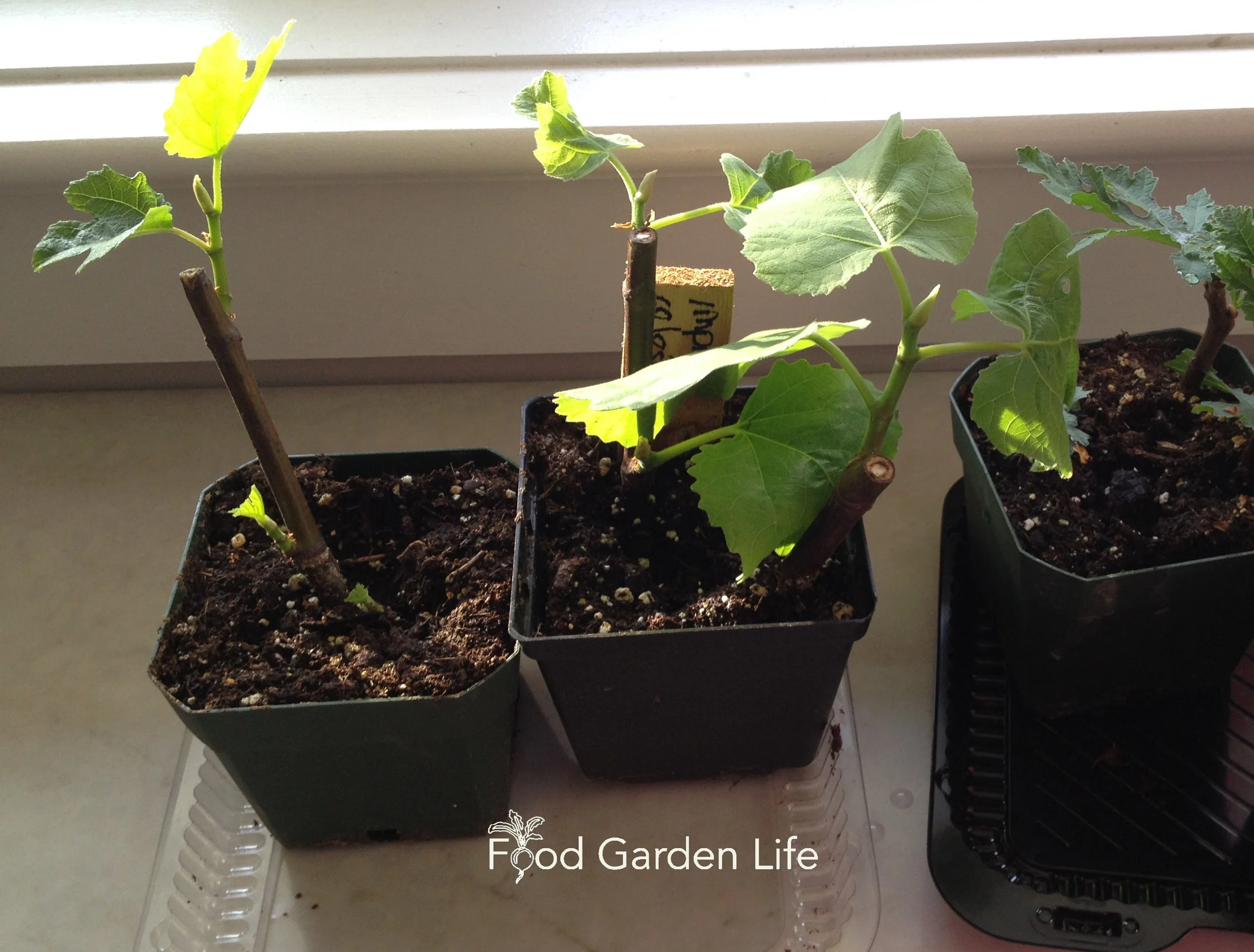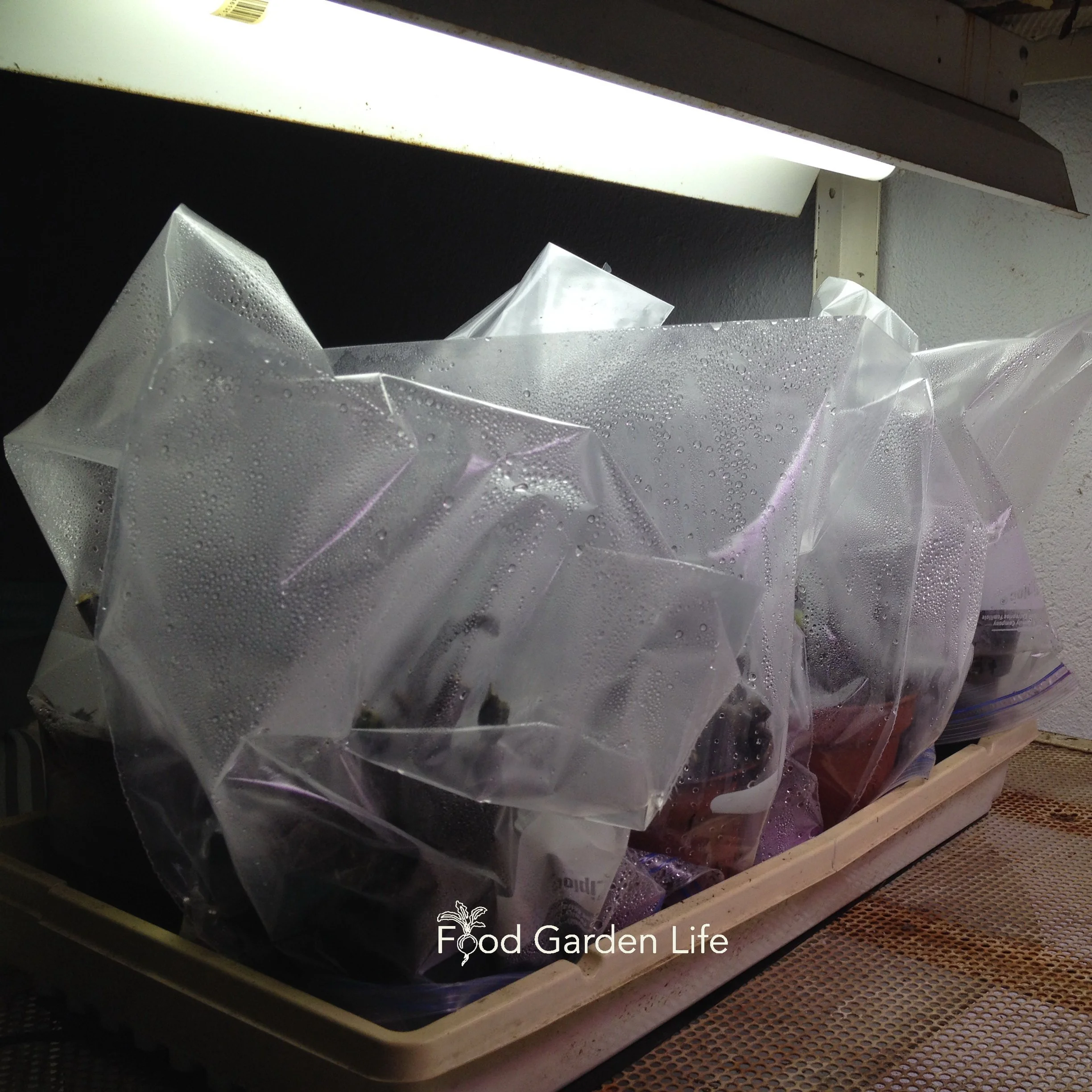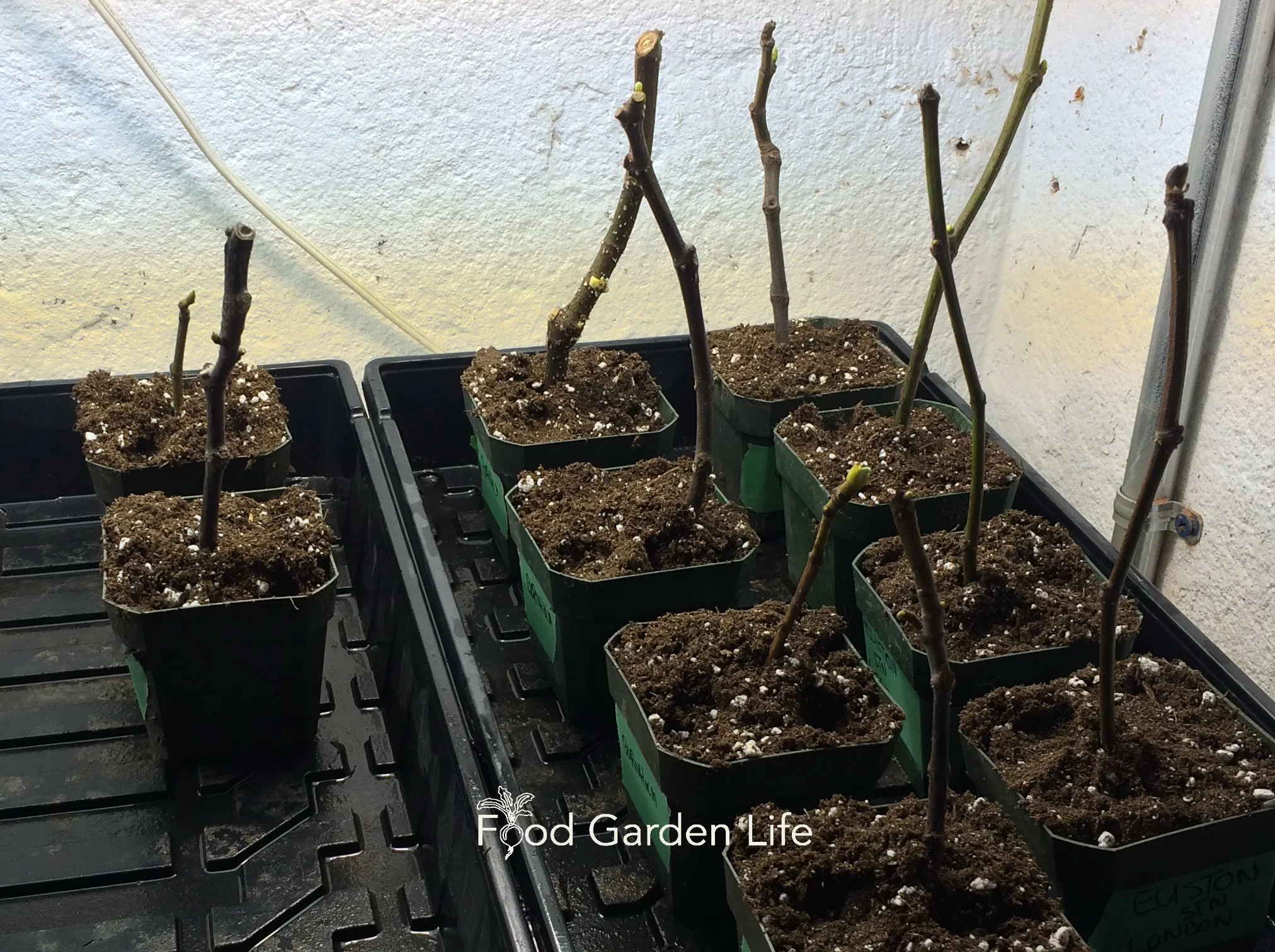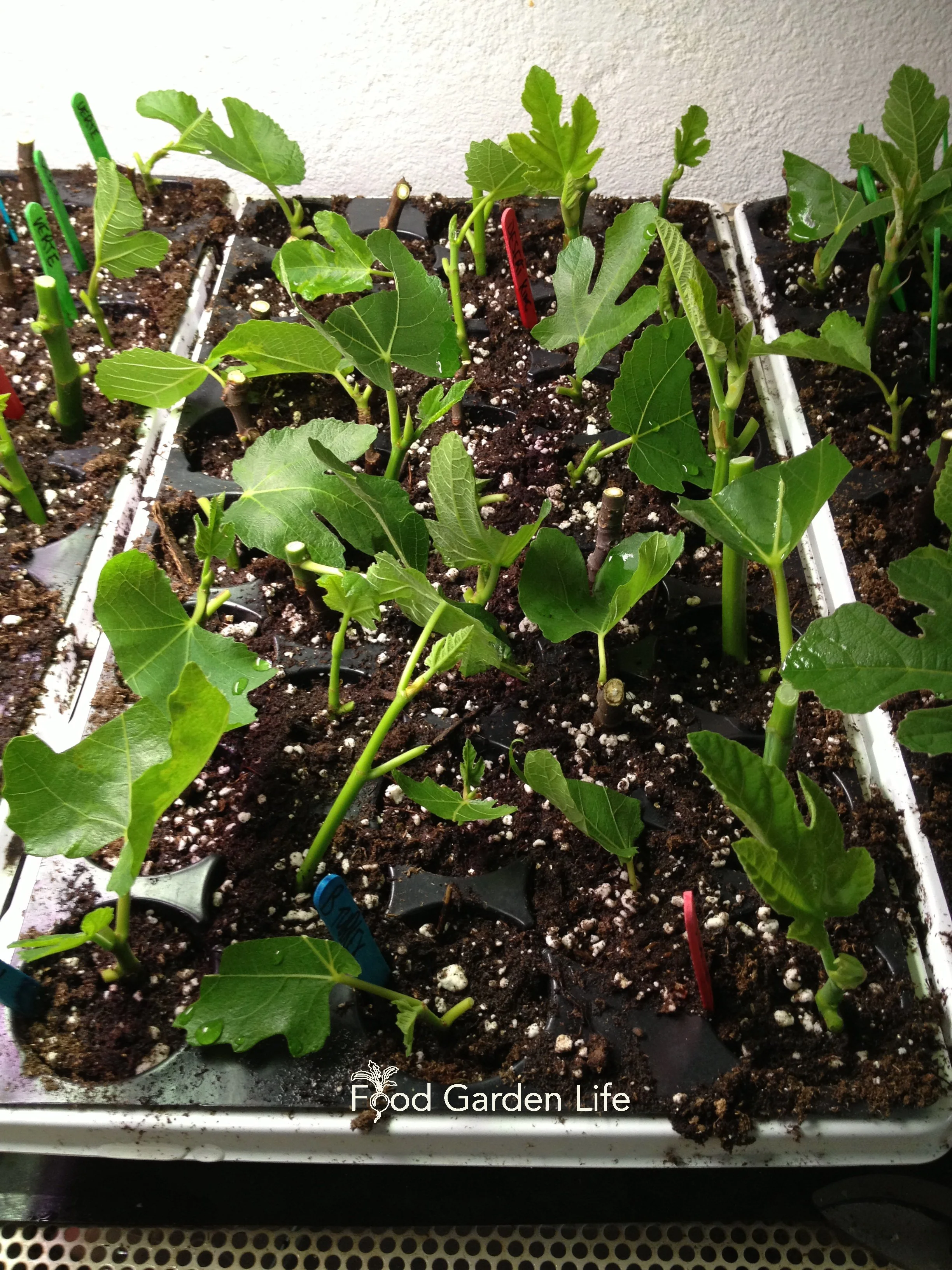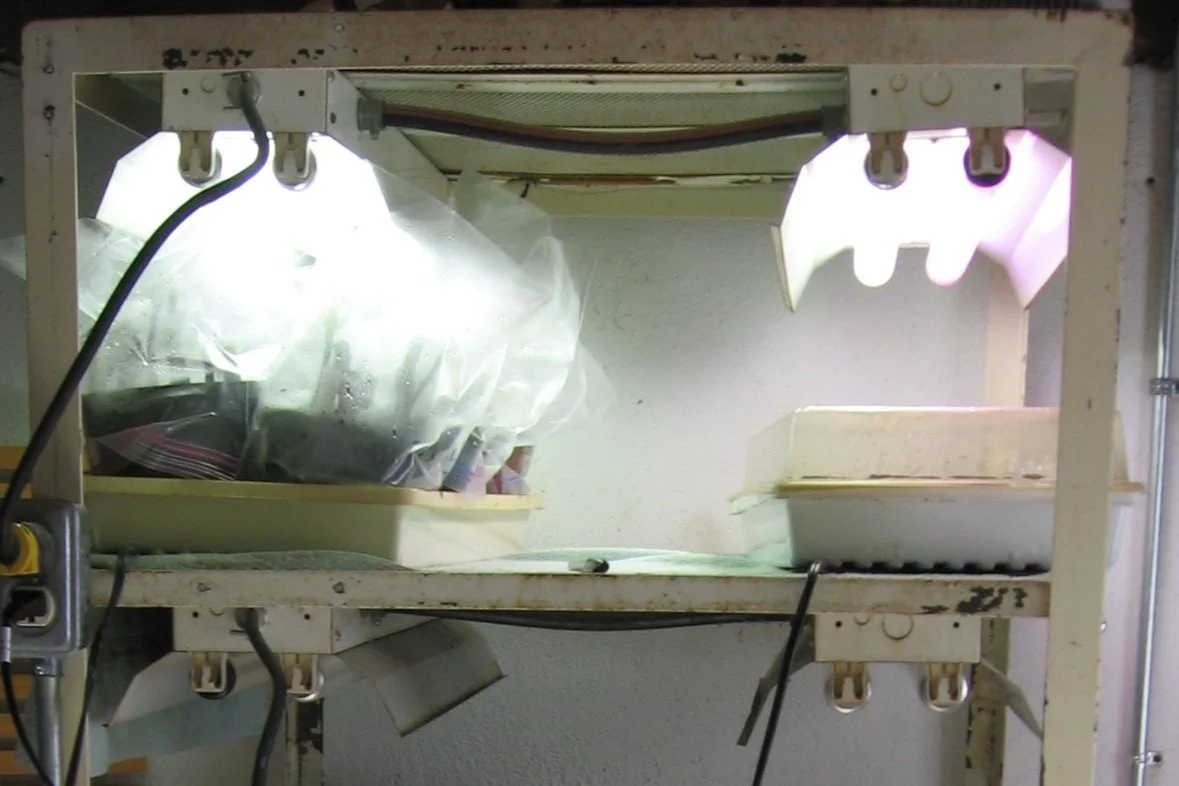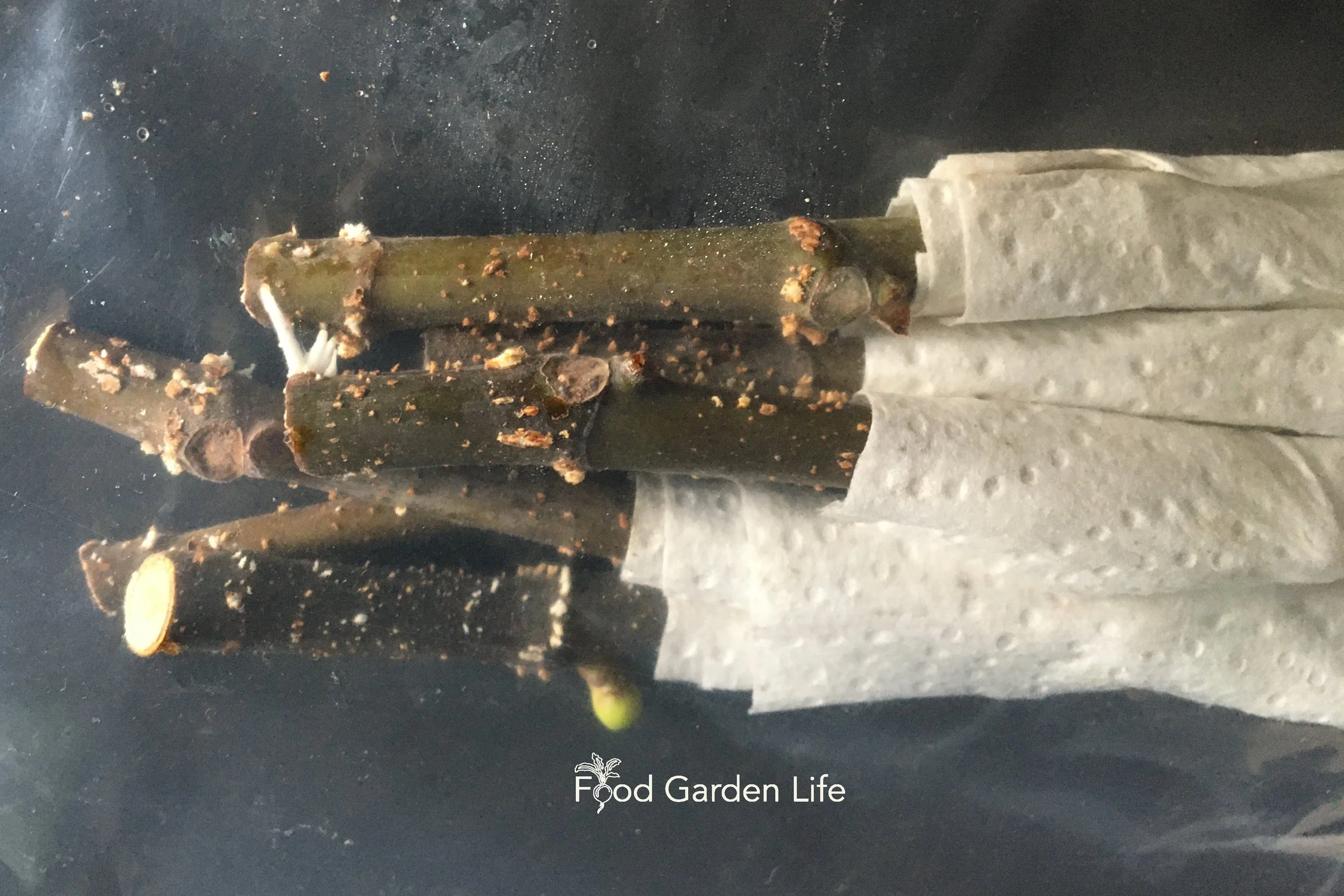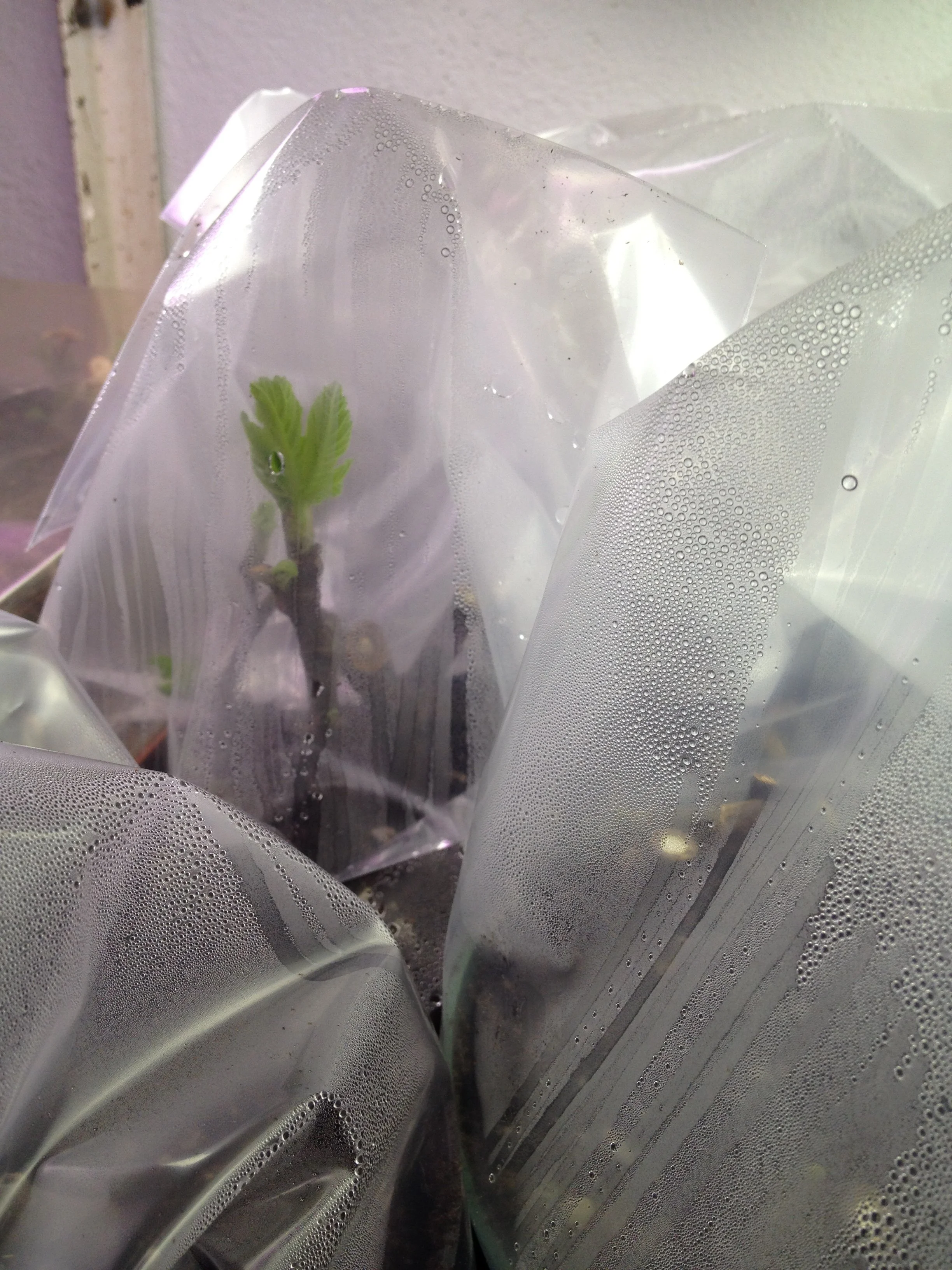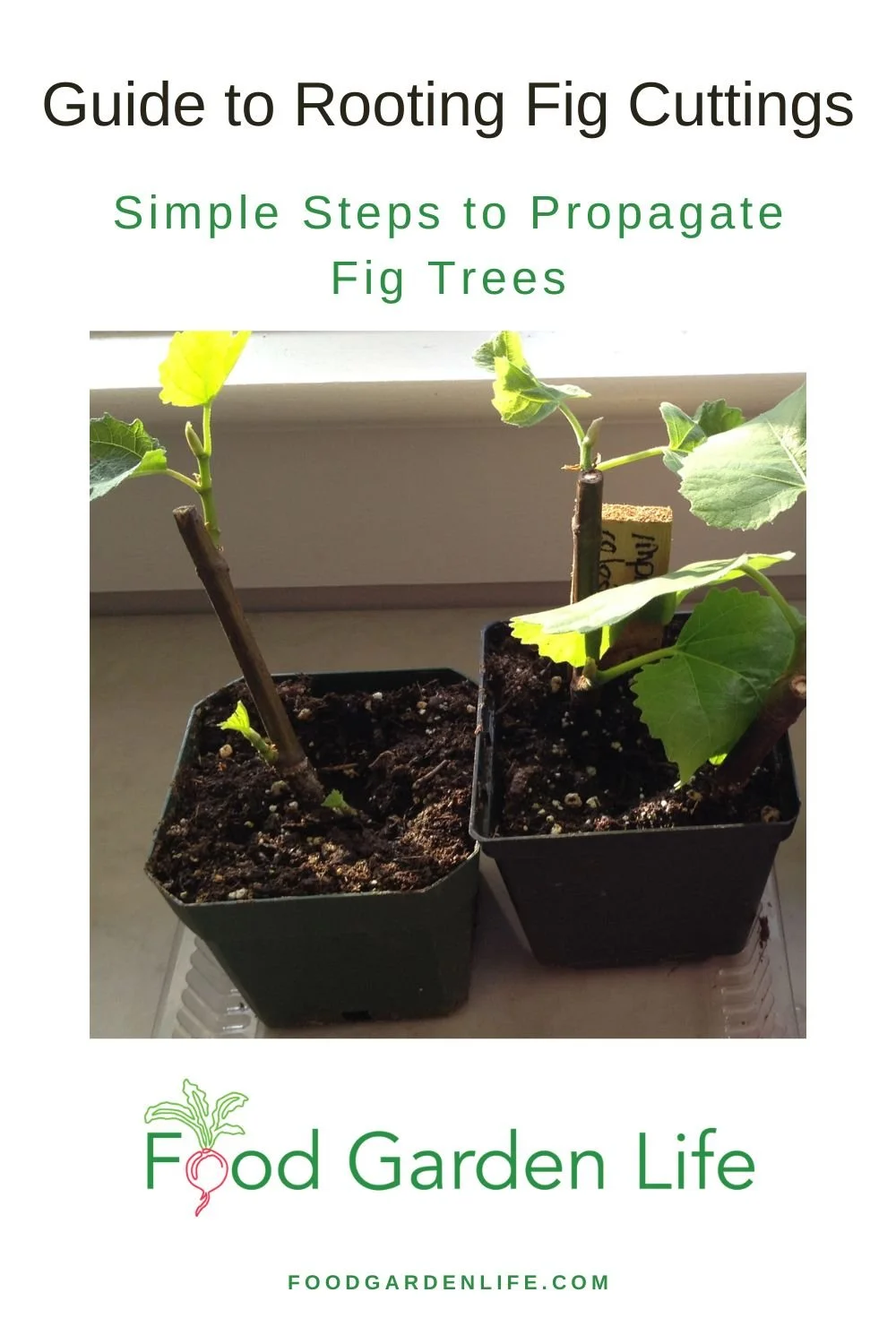Guide to Rooting Fig Cuttings: Simple Steps to Propagate Fig Trees
By Steven Biggs
How to Propagate a Fig Tree
Find out how to propagate a fig tree with cuttings.
My friend Dave recently asked me to help him find a home for a couple dozen potted fig trees. He had more plants than he needed…and not enough space in his garage to store them for the winter.
Dave’s like me: He needs another fig tree like he needs a hole in the head.
But, like me, he just can’t help rooting cuttings.
He grew all those extra fig plants from cuttings. From little sticks.
If you’re interested in growing figs, propagating fig trees from cuttings is a simple way to get more fig plants, and to share and trade great fig varieties.
This post gives you easy-to-follow tips for rooting fig cuttings.
Why Propagate Figs with Cuttings
How Difficult is it Rooting Figs?
All we’re doing is taking pieces of stem—cuttings—and helping those bits of stem grow roots to make a new fig tree.
Rooting fig cuttings is very doable for new gardeners. You don’t need a complicated setup or fancy accessories. (See Supplies to Root Fig Cuttings, below.)
Many people are familiar with how easy it is to grow watercress or mint from the grocery store. Put them in water to keep them fresh and, before you know it, they’ve made roots. Figs aren’t quite that easy to root, but rooting fig cuttings is much easier than most woody plants.
Limited Choice at Garden Centres
Another reason to propagate with fig tree cuttings is that the selection of fig varieties at garden centres is usually limited.
Once you figure out (sorry about the pun) how to grow fig tree cuttings, you have access to a lot of very delicious and early-ripening fig varieties.
Cuttings make it easy and inexpensive to shop (or trade) for great varieties.
Want to find a good fig tree variety for cold climates? Here’s a guide to cold-climate fig varieties.
When: Best Time to Root Fig Cuttings
I mostly root cuttings over the winter. In fall, I prune my dormant fig trees after they’ve dropped their leaves. I save the branches I’ve pruned off to make cuttings.
After I cut the branches into pieces to make cuttings, I store these cuttings somewhere cool until I’m ready to grow them. (See Fig Cutting Size, below.)
If you’re new to this, I suggest you start with cuttings you take from a dormant tree because they are woodier—and these woodier cuttings are a bit easier to deal with than tender green ones in summer (called “softwood” cuttings.)
Find out more about how to prune a fig tree.
Where to Root Fig Cuttings
Pictured are young fig plants near my kitchen window. I rooted them from cuttings under artificial lights during the winter. (They would have rooted well beside a window, too.)
If you have a space set up for propagation, that’s great. But don’t feel you need an elaborate setup if you don’t.
When I started rooting figs, it was under my fluorescent lights that I use to start tomato seedlings.
I’ve rooted cuttings on my kitchen counter, in front of the window.
I’ve rooted them on my dining room floor—by the window. (My wife gave me a dirty look when I lined up a convoy of little pots in the dining room!)
I’ve rooted figs in a pot, under a bush.
When it comes to the “where,” you have options. Indoors. Outdoors. Living space. Utility area.
Let’s think about this in a bit more detail…
Indoors
Lots of fig gardeners start cuttings indoors in the winter or early spring, using dormant cuttings. That’s because there’s frenzied trading and buying of dormant cuttings that goes on in the fall…and people can get started with fig propagation over the dormant season.
As I write this it’s late fall, and I have cuttings in my fridge.
These cuttings are shoots that I removed when I trimmed my dormant fig trees. I wrapped them in damp paper towels, then placed them in a sealed plastic bag.
When I fire up my grow lights in January, I’ll stick some of those cuttings in pots, and root them.
Thinking about where to start your cuttings, here are a couple of helpful things:
Root your cuttings somewhere you’ll see them and remember to check on them regularly
Choose a space with room temperature or warmer (the warmer, the faster!)
Outdoors
When you grow indoors, you can control the conditions and get a good success rate. Outdoors is different. You have less control…but it’s simple.
But that doesn’t mean you can’t grow cuttings outdoors. If I prune or accidentally break a branch in the summer, I’ll pot up the cutting and put it somewhere shady.
Even more simple is to stick cuttings straight into the garden.
(If you have leftover dormant cuttings in your fridge when spring arrives, instead of throwing them out, stick them somewhere protected, in the garden.)
Cuttings: Fig Cutting Size
I aim for a cutting length of at least 6”
For starters, make a clean cut with pruning shears.
I usually make cuttings about 6” long, so that they contain at least 3 nodes (the bumps where the leaf was attached to the stem). But it’s not an exact science. Shorter or longer is usually fine.
The longer the cutting, the more stored energy it has to help it along the way
But if you have only one stem piece of a special variety, you’ll want to decide whether you should make one larger cutting—or two smaller ones (fig insurance!)
(I chatted with a fig collector who travelled a lot in Mediterranean countries. He was a non-smoker. But he’d always buy a packet of cigarettes in his travels. When he found a fig tree he liked, he’d make cuttings, and prune them to the size of a cigarette. Then he’d remove cigarettes and replace them with cuttings. So you can imagine that his cuttings were small. But that’s he got them through customs.)
What About Trimming Off Leaves?
If you’re rooting actively growing branches in summer, you can prune off most of the leaves.
If it’s summer and you’re rooting a branch that’s growing and has leaves, you can leave a small leaf near the top of the cutting—but remove the rest. If you’ve left on a leaf and it falls off, don’t worry—more grow if the cutting roots and starts to grow.
What You Need
Fig Propagation Supplies
Fig Cutting. See Fig Cutting Size above.
Pot. I reuse 3” flower pots. You don’t need any special sort of pot.
Potting Soil. Get a good quality soil mixture. Peat moss or coir-based are what’s usually available commercially. (I don’t recommend using your own compost or garden soil. Garden soil packs down to much; and compost can contain fungus gnats (more on fungus gnats in 4 Tips to Boost Your Success with Fig Cuttings, below.)
Humidity. You’ve just stressed this little piece of branch by removing it from the tree. To help it recover and grow roots, put a clear plastic bag over it to keep humidity levels high around the cutting and help prevent it from drying out. In houses with forced-air heating, the air can get too dry for cuttings over the winter. Another option is to use tall clear domes to cover entire trays of plants.
Light. A bright window is fine. My artificial lights are a simple setup with T12 fluorescent tubes. You don’t need anything fancy.
Labels. Label your cuttings! There’s nothing more disheartening than rooting a cutting, only to forget what it is. (For cuttings, I like wooden tongue depressors, which I compost afterwards—or a bit of masking tape on the pot. But for mature plants, I use something more permanent, like a metal label.)
Get Your Fig Trees Through Winter
And eat fresh homegrown figs!
What You Don’t Need
Optional
Heat Mat. Keep fig cuttings warm. They root more quickly when the temperature is a bit above room temperature. But if you don’t have a heat mat, it’s optional. (Back to my dining room floor…I root cuttings there too because it’s a heated floor. If you have a hot-water radiator, maybe you could root cuttings on top of it.)
Rooting Hormone. It doesn’t hurt. But cuttings root well without it.
Wrap. Some fig-growers wrap the exposed end of cuttings with a stretchy, biodegradable film to keep in moisture. The film is instead of a clear plastic bag or dome. This is a slick method, as the plant can send out a bud right through the film. (It’s great for fruit tree grafting too.) The film is called Parafilm or buddy tape—and is often sold with fruit-tree grafting supplies. I think it’s great—but I don’t use it because plastic bags cost me nothing J
Don’t Waste Your Money
Fancy Grow Lights. Don’t worry about full-spectrum light systems or light-bulb technology. It doesn’t matter. A bright window or a fluorescent shop light is fine. (The fancy grow lights are for when you’re trying to give ideal light for getting flowers and fruit…like hydroponic tomatoes. You don’t need it for cuttings.)
Fertilizer for Cuttings. Don’t. The cuttings have no roots. They don’t need fertilizer yet. Even once root growth starts, don’t feed yet…the roots are still delicate.
Misting Systems. I’d love a misting system… But you can root fig cuttings well without one.
Extra Deep Pots. Nice if you have them, but you don’t need to buy them specially.
How: Fig Cutting Step-by-Step
Simplest Method
Below is my approach. There are many ways you can root cuttings—so you can adapt this to fit what’s practical for you.
Here’s What I Do
Fill the pot with moist potting soil.
Insert the cutting, bottom-end facing down.
Water well.
Cover with clear plastic bag or dome.
Place the pot in a bright warm location.
Ongoing Care
Simple fluorescent shop lights work well.
Keep the soil moist (not sopping wet).
As the cutting starts to grow, the bag doesn’t have to stay on…there might be too much humidity as leaves grow. So remove it—or lift it up part of the way to allow in some air. If you’re using a dome, set is askew for air circulation.
There are Other Fig Propagation Methods
Pre-Rooting Fig Cuttings Without Soil. More details below—but the idea is to get roots growing even before you put your fig cutting in soil!
Fig Cuttings in Water. I think this approach appeals to people because it’s familiar. My mom always rooting things in cups of water on the kitchen windowsill—slips of impatiens, coleus…or the avocado pit suspended with toothpicks. Yes, it can work; but you probably won’t have as many cuttings root than if you use the method above.
Bag Instead of Pot. Some growers like to insert a fig cutting into a plastic bag filled with moistened potting soil. After the fig cutting is inserted, the bag is sealed around the cutting to keep it moist inside. It’s a neat idea, because it deals with two things: watering and fungus gnats. (More on fungus gnats below.) This method of rooting cuttings is often called the “fig pop” method. In the deluxe version of this technique, you wrap the exposed end of the cutting with film.
Pre-Root Fig Cuttings
Pre-root cuttings somewhere warm. No light needed!
Woodier, dormant cuttings grow roots without soil if they’re in warm, moist conditions. No light needed! This means that you can “pre-root” them before potting them up.
A simple way to pre-root dormant cuttings is as follows:
Wrap cuttings in moist paper towel
Place towel-wrapped cuttings in a sealed plastic bag (use a clear bag, so you can watch what’s happening inside)
Place the bag somewhere warm—warmer than room temperature is best (for example, on a heated floor, or on top of a refrigerator)
TIP: I don’t wrap the bottom inch or so of the cutting with paper towel; it’s where I want roots—and then I can see how things are going.
The paper towel should be moist—but you don’t want water pooled anywhere in the bag, because there’s more chance of rot.
You’ll eventually see white flecks form on the cuttings. These are “callus.” It’s what grows before the roots. The callus means things are underway!
When roots have formed, pot up your cuttings—but remember that the small roots are delicate.
Pre-rooting in perlite.
A huge advantage to pre-rooting cuttings is that there is less of a window for fungus gnats to destroy the delicate roots of young fig plants.
VARIATION: I’ve also pre-rooted fig cuttings in damp perlite.
Time to Root Cuttings
How long does it take for a fig cutting to root?
How long it takes depends on the conditions.
If you put your cuttings in a warm spot, they’ll root more quickly.
Sometimes, roots grow before any leaves—and if you pick up the pot and look at the holes in the bottom, you might see wee white root tips poking out.
4 Tips That Boost Your Success with Fig Cuttings
Here are 4 tips that will help you successfully root cuttings:
1. Store Cuttings Properly
If the cuttings are not properly stored, they dry out. Then it’s game over.
After I prune my dormant fig trees, I store the cuttings in my basement beer fridge. The cool temperature allows me to store them for months. (And they’re in the beer fridge because my family doesn’t want to look at them every time they open the fridge in our kitchen.)
I wrap up the cuttings in damp paper towel, and then place them in a sealed plastic bag. (A zippered freezer bag works well. Some people use plastic cling wrap.)
TIP: The paper towel should be moist—not sopping wet. If it’s too wet, the cuttings might rot.
2. Heat
Heat really helps to speed up rooting. Above 20°C (68°F) is best.
When rooting cuttings in a cooler area (e.g. my basement) it’s easier and less expensive to heat the cuttings from underneath with a heat mat than to heat the whole room.
If you don't have a heat mat, placing cuttings on top of a hot water radiator or a heated floor can help.
3. Humidity for Unrooted Fig Cuttings
High humidity with a clear plastic bag.
Once potted up, cuttings can quickly dry out. Keep humidity higher until they’ve rooted and are growing leaves.
Here are ideas for keeping the humidity high:
Cover pots with a clear plastic bag
Cover pots with an inverted jar
Cover a tray of pots with a clear dome
I don’t often see the tall domes at local garden centres, but they are available through specialty horticultural suppliers and are worth the search if you plan to root a lot of cuttings.
4. Beware of Fungus Gnats
Fungus gnats (flying insects that look like fruit flies) can be a BIG problem. The worm-like juvenile stage lives in the soil. You won’t see it—but it eats roots…and loves fig roots. They can quickly kill newly formed roots on young cuttings.
Here’s how I avoid fungus gnats on fig cuttings:
Start with a clean potting mix. Fungus gnat eggs and larvae can be in a potting soil, so this isn’t a time to recycle potting soil that you’ve used elsewhere.
Isolate your cuttings from other plants that might have fungus gnats already living in the soil. (For most houseplants, they’re more of a nuisance than a threat.)
Find out everything you need to know about controlling fungus gnats in fig cuttings.
Where to Get Fig Cuttings
Connect with other fig enthusiasts to buy or trade cuttings.
As plants go dormant in fall and people prune, there’s a fig-trading frenzy as people mail each other cuttings.
There are fig-focused groups on social media
Ourfigs.com is an online fig forum where you can connect with other fig enthusiasts
Get Your Fig Trees Through Winter
And eat fresh homegrown figs!
Fig Cutting FAQ
What about scoring the cuttings?
Some people “score” the base of cuttings. It just means removing some of the bark to help with root formation. I’ve never found it necessary, but it won’t do any harm.
Can I leave the little figs on the cuttings?
Remove any little figs.
If it’s a dormant cutting with a fig that didn’t finish ripening during the growing season, that little fig would never ripen anyway.
If it’s a green cutting in summer, remove the fig so that no energy is wasted trying to ripen the fig.
And if you’re rooting a dormant cutting and it grows a new fig as it comes out of dormancy (a “breba” fig), take it off. The cutting doesn’t have the energy to grow and ripen it. At this point, your goal is roots…not figs!
Can I root green softwood fig cuttings?
Sure. They’re easy to root; maybe a bit more delicate than woodier cuttings from year-old wood.
How many of my cuttings will root?
So many things come into play that there’s no point trying to give a percentage that you can expect to root.
But it’s fair to say that as you get practice, you will consistently be able to get more than half of your cuttings to root. Or more!
Are there other ways to propagate fig trees?
Yes! Layering and air layering both work very well.
Pin this post!
You can also bud figs, though I’ve never seen the point in doing this as they grow so easily on their own roots. I guess if you wanted a fig tree with more than one variety it makes sense.
(Budding is when we take a bud—a little piece of a variety we want fruit from—and put it on another plant that provides the roots. It’s a way to make lots of plants from a small amount of wood, and is used to reproduce many types of fruit trees.)
We don’t usually grow figs (or apples or other fruit trees) from seed because it’s like buying a lottery ticket. You might get the prize of a variety with nice fruit; probably not. It probably won’t be like the fig it came from…and it might even be a variety that gives tough, leathery figs.
Can fig cuttings root in water?
It can work. But you’ll get better results with other methods—so unless you’re determined to try this method, I’d choose something else.
Do I need to wash or sanitize my cuttings?
Some people do. I don’t.
More: How to Propagate Fig Trees
Air layering is a simple way to propagate fig trees.
More on How to Grow Figs
More Fig Articles
Head back to the fig home page to search for fig articles by topic.
Fig Books
Fig Masterclass
The self-paced online fig masterclass gives you everything you need to know to grow and harvest your own figs in a cold climate!
One-on-One Fig Adice
If you want a consultation about growing figs in cold climate to talk specifically about your situation and challenges, book it below.

